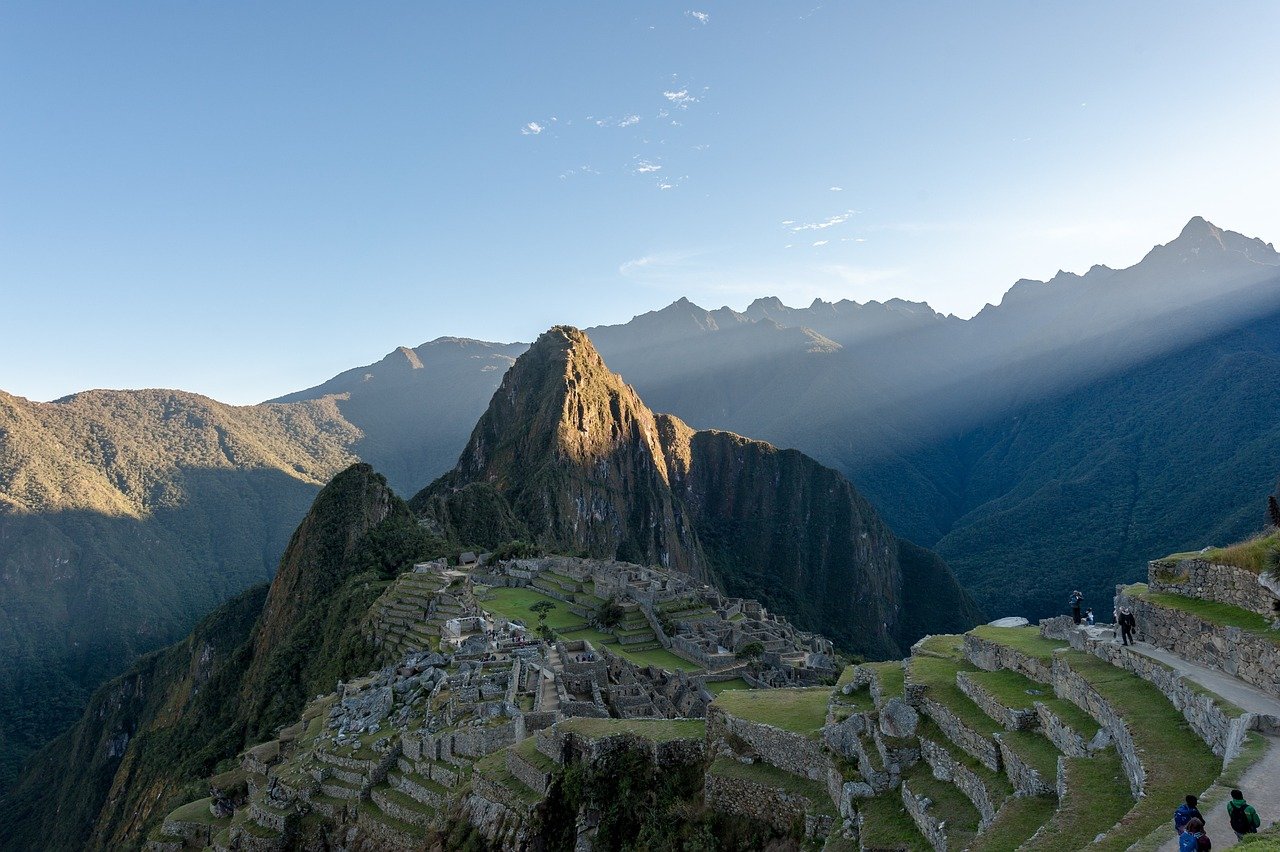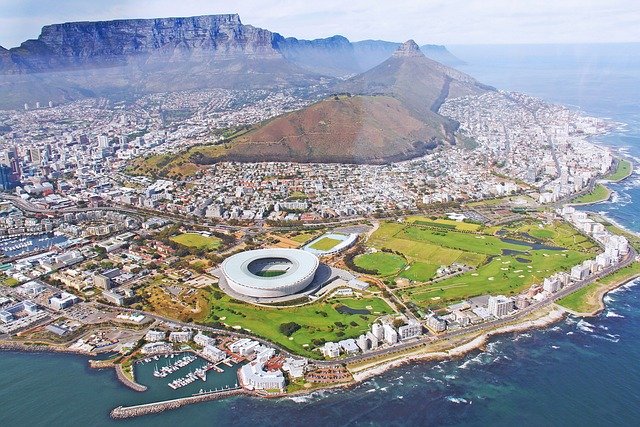THE INCA TRAIL: TRAVEL GUIDE
Walking the Path of the Incas: A Journey Through Time
In the misty heights of the Peruvian Andes, where the clouds embrace ancient stone pathways and emerald peaks pierce the sky, lies one of humanity’s greatest achievements: the Inca Trail. This legendary route is far more than a trek—it’s a pilgrimage through time, a communion with history, and for many, a life-changing journey that culminates in one of the world’s most spectacular sights: Machu Picchu.
As the morning sun breaks through the clouds to illuminate terraced ruins and mist-shrouded mountains, you’ll understand why this 26-mile ancient highway has captivated explorers, archaeologists, and adventurers for generations. Each step on its stone path connects you to the empire that built it—an empire whose engineering prowess and spiritual connection to the landscape continues to inspire awe centuries after its fall.
This guide serves as your comprehensive companion to experiencing the magic of the Inca Trail. Whether you’re a seasoned trekker or embarking on your first multi-day hike, we’ll equip you with everything you need to know—from historical insights and practical preparations to cultural encounters and environmental considerations—ensuring your journey along this sacred path is as enriching as it is unforgettable.
HISTORICAL CONTEXT: WALKING IN THE FOOTSTEPS OF AN EMPIRE
The Inca Legacy
The Inca Trail is not simply a path—it’s a testament to the ingenuity of the Inca civilization, which flourished from the 13th century until Spanish conquest in the 1500s. The trail we trek today is just a small section of the vast Qhapaq Ñan (Royal Road), an extensive network of over 20,000 miles of pathways that connected the far reaches of the Inca Empire, from modern-day Colombia to Chile.
Built without the use of wheels, iron tools, or draft animals, these masterfully engineered stone pathways demonstrate the Incas’ remarkable ability to work in harmony with the challenging Andean landscape. The trail incorporates steep staircases cut directly into bedrock, tunnels carved through solid stone, and bridges that have withstood centuries of mountain weather.
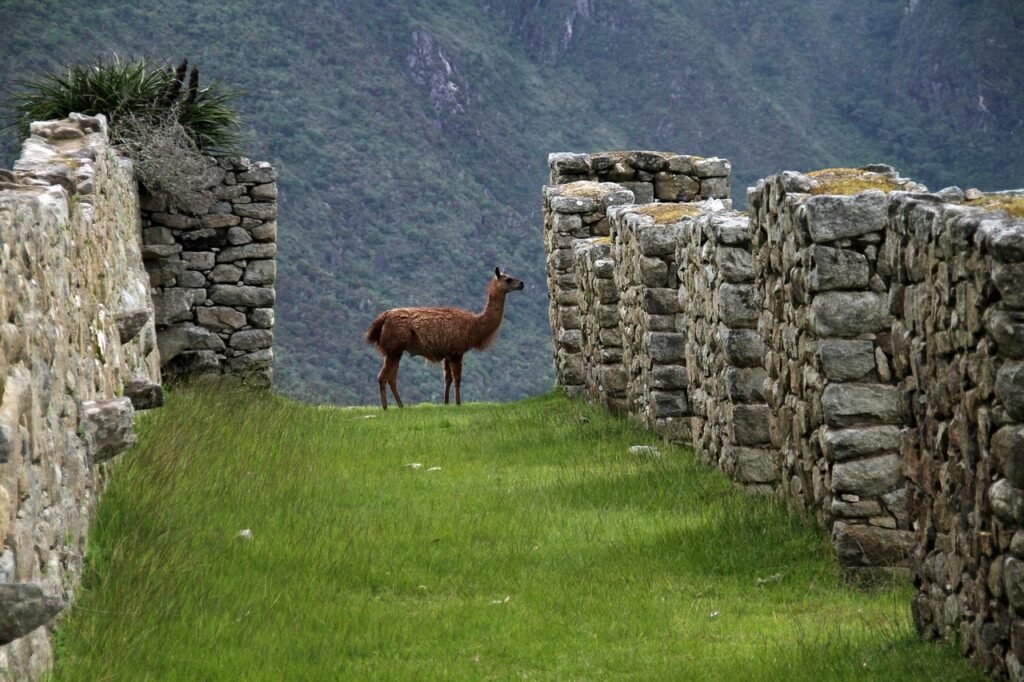
The Sacred Purpose OF THE INCA TRAIL
As you walk, you’ll pass by stone markers and sacred sites that served as waypoints for Inca messengers (chasquis) and nobility making their way to ceremonies at various temples and astronomical observation points. The trail was deliberately designed to provide spectacular views and dramatic reveals of important sites, culminating in the breathtaking first glimpse of Machu Picchu from the Sun Gate (Inti Punku).
Rediscovery and Modern Recognition
While local people always knew of these paths, the Inca Trail and Machu Picchu entered global consciousness after Hiram Bingham’s 1911 “scientific discovery” of the citadel. As interest in the site grew throughout the 20th century, the trail evolved from an archaeological curiosity to one of the world’s most famous treks.
In recognition of its cultural and historical significance, the Inca Trail was designated part of a UNESCO World Heritage Site in 1983. Today, strict regulations limit the number of hikers to preserve its integrity, making it one of South America’s most sought-after trekking permits.
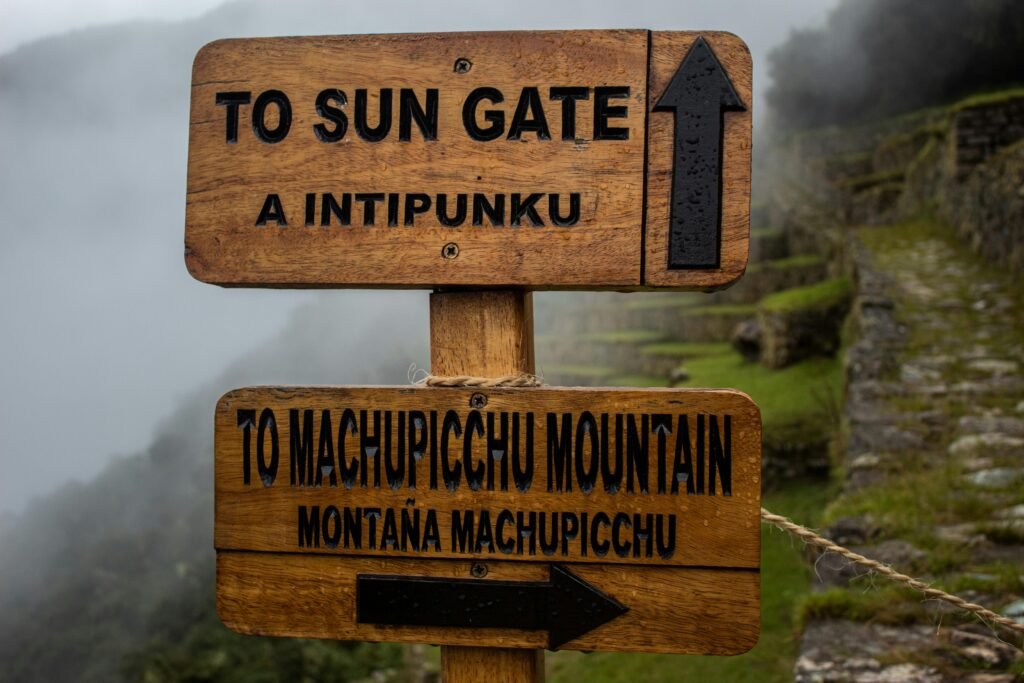
TREKKING OPTIONS: CHOOSING YOUR INCA ADVENTURE
The Classic Inca Trail (4 Days/3 Nights)
Distance: 26 miles (43 kilometers)
Difficulty: Moderate to challenging
Maximum Altitude: 13,828 ft (4,215 m) at Dead Woman’s Pass
Permits Required: Yes, limited to 500 people per day (including guides and porters)
For the Incas, these paths were not merely functional—they were sacred highways connecting important ceremonial sites. The classic Inca Trail was not a common trade route but rather a pilgrimage path with religious significance, linking important ceremonial sites and providing a ritualistic approach to the sacred city of Machu Picchu.
The traditional and most popular route, the Classic Inca Trail provides the complete experience, taking you through diverse ecosystems from high alpine tundra to cloud forest. This journey features numerous archaeological sites, culminating in the sunrise arrival at Machu Picchu via the Sun Gate.
Highlights:
- The challenging ascent and triumphant conquest of Dead Woman’s Pass
- Exploration of fascinating ruins like Runkurakay, Sayacmarca, and Phuyupatamarca
- Diverse ecosystems and abundant wildlife viewing opportunities
- The emotional sunrise arrival at Machu Picchu through the Sun Gate

The Short Inca Trail (2 Days/1 Night)
Distance: 8 miles (13 kilometers)
Difficulty: Moderate
Maximum Altitude: 8,792 ft (2,680 m)
Permits Required: Yes, limited spaces available daily
Perfect for travelers with limited time or those who prefer a less physically demanding experience, the Short Inca Trail captures the essence of the journey in a condensed format. Beginning at KM 104 of the railway to Aguas Calientes, this route still allows you to experience the thrill of entering Machu Picchu through the Sun Gate.
Highlights:
- Visits to Chachabamba and Wiñay Wayna archaeological sites
- Stunning views of the Urubamba River valley
- The magical experience of entering Machu Picchu through the Sun Gate
- Comfortable overnight stay in Aguas Calientes before a full day at Machu Picchu
The Salkantay Trek (5 Days/4 Nights)
Distance: 46 miles (74 kilometers)
Difficulty: Challenging
Maximum Altitude: 15,092 ft (4,600 m) at Salkantay Pass
Permits Required: No (making it an excellent alternative when Inca Trail permits are sold out)
While not part of the historical Inca Trail, the Salkantay Trek is a spectacular alternative that eventually connects with the trail network near Machu Picchu. This challenging route offers more solitude and passes beneath the magnificent Salkantay Mountain (20,574 ft/6,271 m), considered sacred by local people.
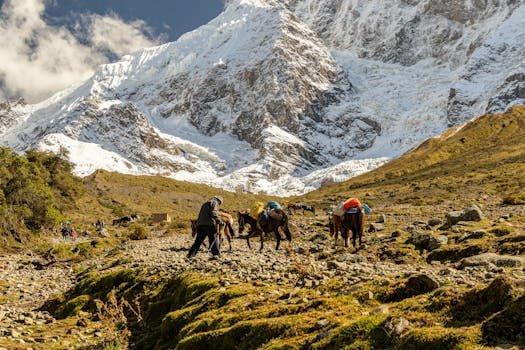
Highlights:
- The breathtaking Salkantay Pass with views of snow-capped peaks
- Dramatic transitions from alpine terrain to lush cloud forest
- Coffee plantations and tropical fruit sampling in lower elevations
- Less crowded trails and more immersive wilderness experience
The Lares Trek (4 Days/3 Nights)
Distance: Varies by route, typically around 21 miles (33 kilometers)
Difficulty: Moderate
Maximum Altitude: 15,583 ft (4,750 m)
Permits Required: No
The Lares Trek offers a more cultural focus, passing through traditional Quechua villages where locals still maintain ancient weaving techniques and agricultural practices. While this route doesn’t follow historical Inca pathways, it provides an authentic glimpse into contemporary Andean life while still concluding with a visit to Machu Picchu via train.
Highlights:
- Encounters with local communities and opportunities to learn about traditional crafts
- Hot springs for soaking tired muscles
- Stunning high-altitude lakes and mountain scenery
- Less crowded trail experience with more flexibility in departures
PLANNING AND PREPARATION: SETTING YOURSELF UP FOR SUCCESS
Permits and Booking
The Inca Trail’s popularity, combined with conservation efforts, has led to strict limitations on daily trekkers. Here’s what you need to know:
- Classic Inca Trail permits: Limited to 500 people daily (including guides and porters), typically released in October for the following year and sell out months in advance for peak season (May-September)
- Booking timeline: Reserve 6-9 months in advance for high season treks, 3-6 months for shoulder seasons
- How to book: Permits can only be purchased through authorized agencies in Peru; independent travelers cannot purchase permits directly
- Required documentation: Your passport is needed for permit reservation, and you must bring the same passport on the trek
- Cancellation policy: Permits are non-refundable and non-transferable once issued
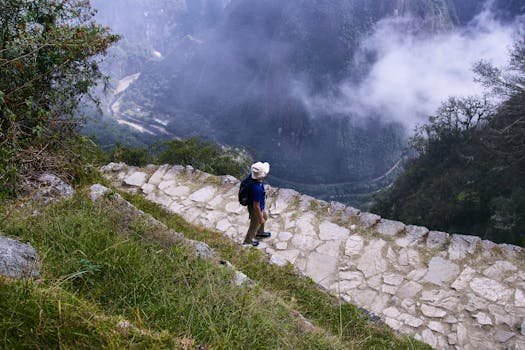
Physical Preparation FOR THE INCA TRAIL
The Inca Trail’s combination of high altitude, steep ascents/descents, and long hiking days demands proper physical conditioning:
- Cardiovascular training: Begin 3-6 months before your trek with regular aerobic exercise (hiking, stair climbing, cycling)
- Strength training: Focus on leg and core strength to prepare for steep sections and uneven terrain
- Practice hikes: Incorporate loaded day hikes with your actual backpack in the months before departure
- Altitude acclimatization: Plan to spend at least 2-3 days in Cusco (11,152 ft/3,399 m) before beginning your trek
- Realistic assessment: Be honest about your fitness level when selecting your trek; the Inca Trail is not recommended for complete beginners

Essential Packing List
What you bring can make or break your Inca Trail experience. Here’s what you shouldn’t leave home without:
Clothing:
- Moisture-wicking base layers
- Insulating mid-layers (fleece or down)
- Waterproof rain jacket and pants
- Convertible hiking pants
- Sturdy, broken-in hiking boots
- Hiking socks (3-4 pairs)
- Warm hat and sun hat
- Gloves
- Swimsuit (for hot springs on certain routes)
Gear:
- Backpack (30-40L for those using porters, 50-65L for independent trekkers)
- Trekking poles with rubber tips (mandatory for protecting stone pathways)
- Headlamp with extra batteries
- Sleeping bag rated for 20°F/-7°C
- Sleeping pad (if not provided by tour company)
- Water purification method
- Water bottles or hydration reservoir (minimum 2 liters capacity)
Personal Items:
- Sunscreen (SPF 50+) and lip balm with sun protection
- Insect repellent
- Personal first aid kit including blister treatment
- Toilet paper and hand sanitizer
- Quick-dry towel
- Camera with extra batteries
- Power bank for electronics
- Cash for tips and emergencies (small denominations)
Documents:
- Passport (must be the same one used to secure your permit)
- Insurance information
- Tour reservation details
- Necessary medications with prescriptions
See our checklist for multiday treks.
Budget Considerations
A realistic budget helps avoid surprises and ensures you can fully enjoy your experience:
- Classic Inca Trail tour costs: $600-$1,200 USD per person, depending on group size and service level
- Alternative treks: Generally $400-$800 USD
- Additional expenses: Tips for guides and porters ($50-$80 total), extra snacks and water on the trail, equipment rental if needed
- Pre-trek costs: Accommodations in Cusco, meals, and acclimatization activities
- Post-trek considerations: Celebratory meal, accommodations, and potential recovery day in Aguas Calientes or Cusco
GUIDED TOURS VS. INDEPENDENT TREKKING: MAKING THE RIGHT CHOICE
Guided Tours: The Standard Approach
Pros:
- Local expertise and cultural/historical insights from professional guides
- Logistical support including equipment transport, meal preparation, and campsite setup
- Emergency response protocols and first aid-trained personnel
- Built-in community with fellow trekkers
- Often includes high-quality equipment and nutritious meals
- Support for local economy through employment of guides and porters
Cons:
- Higher cost compared to independent options
- Less flexibility with pace and schedule
- Group dynamics can impact personal experience
- Limited solitude and personal space
Cost range: $600-$1,200 USD for Classic Inca Trail
Best for: First-time visitors to Peru, those seeking educational content, travelers prioritizing comfort, solo trekkers looking for community
Independent Trekking: Limited Options
It’s important to note that truly independent trekking on the Classic Inca Trail is not permitted. All trekkers must be accompanied by a licensed guide. However, for alternative routes like Salkantay, independent options exist:
Pros:
- Lower cost
- Complete control over pace, schedule, and camping locations
- Solitude and personal connection with the landscape
- Sense of self-reliance and adventure
Cons:
- Significantly greater physical challenge (carrying all gear and food)
- Lack of expert interpretation of archaeological sites
- Increased responsibility for navigation and safety
- No support in case of emergency
- Limited or no interaction with local communities
Cost range: $200-$400 USD (equipment, food, transportation, entrance fees)
Best for: Experienced backcountry hikers, budget travelers with proper preparation, those seeking maximum solitude
Middle Ground: Basic Guided Service
For those seeking a balance, “basic” or “economic” guided services offer essential support without luxury:
What’s included:
- Licensed guide
- Porter support for group equipment
- Simple but nutritious meals
- Basic camping equipment
Cost range: $500-$700 USD
Best for: Budget-conscious travelers who still want some support, experienced hikers who value cultural interpretation but don’t need luxury

DETAILED ITINERARY: THE CLASSIC INCA TRAIL EXPERIENCE
Day 0: Cusco Preparation
While not officially part of the trek, this crucial acclimatization day sets the foundation for success:
- Attend your pre-trek briefing
- Meet your guide and fellow trekkers
- Receive any rented equipment
- Pack and organize your gear
- Early dinner and bedtime (typical pickup time is 4:30-5:30 AM)
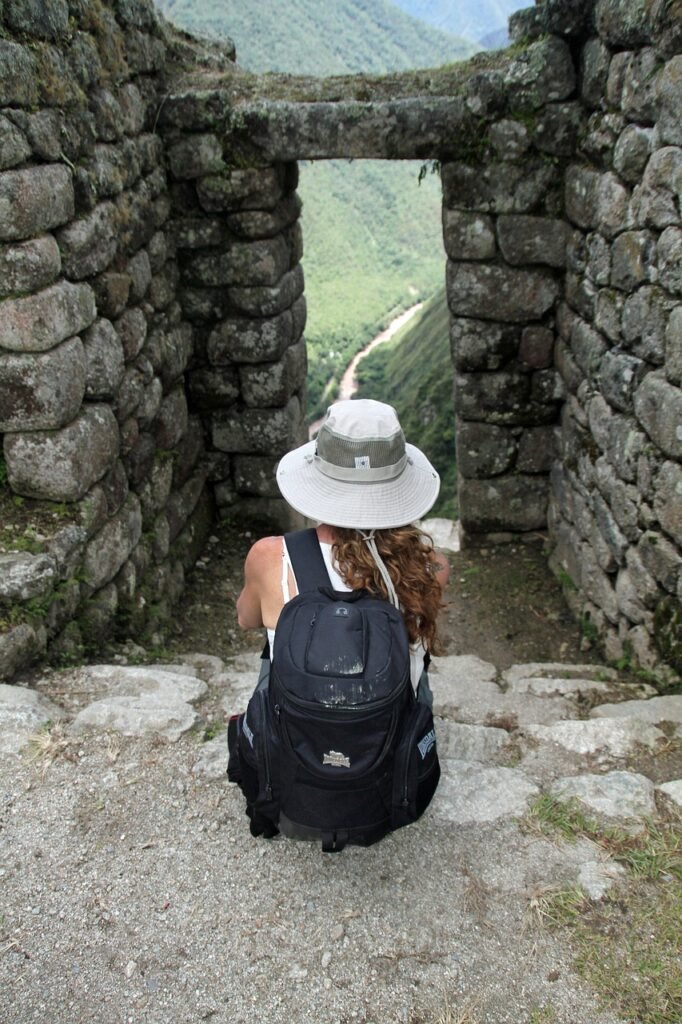
Day 1: Beginning the Journey (7.5 miles/12 km)
Starting elevation: 8,923 ft (2,720 m) at Kilometer 82
Ending elevation: 10,829 ft (3,300 m) at Huayllabamba
Hiking time: 5-6 hours
Difficulty: Moderate
Your adventure begins with an early morning pickup from your Cusco hotel and a scenic bus journey to the trailhead at Kilometer 82. After passing through the official checkpoint (where your passport and permit are verified), you’ll cross the Urubamba River and begin your ascent.
The first day features relatively gentle hiking through semi-arid terrain with spectacular views of snow-capped Mount Veronica (19,334 ft/5,893 m). You’ll pass the Inca sites of Llactapata and Patallacta before lunch, then continue through small farming communities and increasingly lush vegetation as you gain altitude.
By late afternoon, you’ll reach the village of Huayllabamba, the last human settlement on the trail and your first campsite. Here, porters will have tents set up and a hot meal waiting while you marvel at your first night under Andean stars.
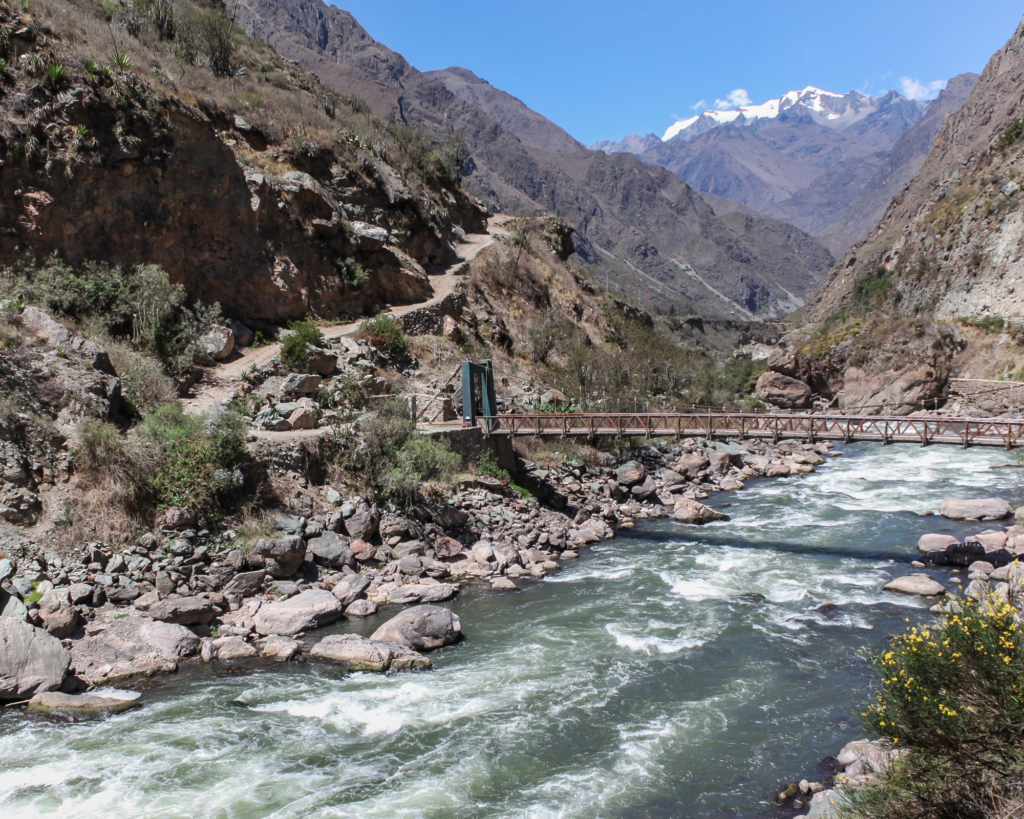
Day 2: The Challenge (6.8 miles/11 km)
Starting elevation: 10,829 ft (3,300 m) at Huayllabamba
Maximum elevation: 13,828 ft (4,215 m) at Dead Woman’s Pass
Ending elevation: 11,811 ft (3,600 m) at Pacaymayo
Hiking time: 6-8 hours
Difficulty: Challenging
The second day presents the trek’s greatest physical challenge: the ascent to Dead Woman’s Pass (Warmiwañusca). After an early breakfast, you’ll begin climbing through changing ecosystems—transitioning from cloud forest with orchids and hummingbirds to high alpine puna with its hardy grasses and breathtaking vistas.
The climb to the pass is strenuous but immensely rewarding. The trail consists of well-built stone stairs that seem to stretch endlessly upward. Many trekkers adopt a “rest step” technique, pausing briefly with each step to manage the altitude. At the summit, celebratory photos and spectacular panoramic views reward your efforts.
After savoring the achievement, you’ll descend a steep stone staircase to the Pacaymayo Valley, where your second night’s campsite awaits. The descent can be challenging for those with knee issues, making trekking poles invaluable. Your body will welcome the hearty dinner and well-earned rest at camp.
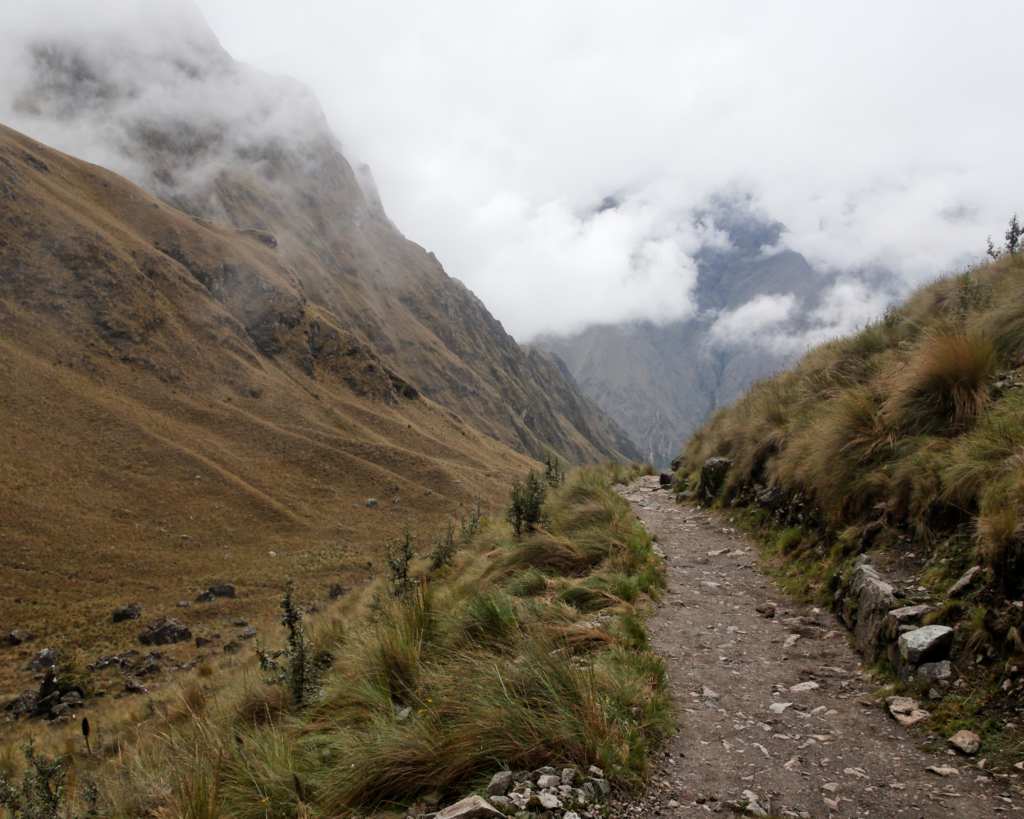
Day 3: Archaeological Wonders (9.3 miles/15 km)
Starting elevation: 11,811 ft (3,600 m) at Pacaymayo
Maximum elevation: 12,959 ft (3,950 m) at Runkurakay Pass
Ending elevation: 8,792 ft (2,680 m) at Wiñay Wayna
Hiking time: 8-10 hours
Difficulty: Moderate to challenging
Often described as the most beautiful day of the trek, Day 3 combines spectacular scenery with fascinating archaeological discoveries. After breakfast, you’ll climb to explore the circular ruins of Runkurakay, an ancient tambo (resting place) for messengers. From there, you’ll ascend to the second pass, where panoramic views of the Vilcabamba and Urubamba mountain ranges await.
The trail continues to the impressive ruins of Sayacmarca (“Inaccessible Town”), perched dramatically on a rocky outcrop. Your guide will lead a tour of this mysterious site, accessible only via a single steep staircase.
After lunch, you’ll enter the most visually stunning section of the trail—cloud forest dense with orchids, hanging mosses, and colorful birds. The path follows an original Inca stone highway, remarkably intact after centuries, until you reach the third pass with views of the snowcapped Salkantay and Veronica peaks.
A short descent brings you to Phuyupatamarca (“Town Above the Clouds”), featuring ceremonial baths with running water—a testament to Inca engineering. From here, a steep descent of 1,000 stone steps leads to your final campsite near Wiñay Wayna (“Forever Young”), an elaborate terraced site with views of the Urubamba River valley.
Day 4: Machu Picchu (3.7 miles/6 km)
Starting elevation: 8,792 ft (2,680 m) at Wiñay Wayna
Ending elevation: 7,972 ft (2,430 m) at Machu Picchu
Hiking time: 2-3 hours to the Sun Gate, plus 4-5 hours exploring Machu Picchu
Difficulty: Easy to moderate
The culmination of your journey begins before dawn. After an early breakfast (typically around 3:30-4:00 AM), you’ll join the line at the checkpoint to continue toward your final destination. Headlamps illuminate the path as you hike through misty cloud forest for about an hour until you reach Inti Punku, the Sun Gate.
Here, weather permitting, you’ll witness the sunrise gradually illuminating Machu Picchu—a profoundly moving moment that brings many trekkers to tears. After soaking in the view and taking photos, you’ll descend for about 45 minutes to the citadel itself.
Your guide will provide a 2-3 hour tour of the main structures, explaining the sophisticated construction techniques and theories about the site’s purpose. Afterward, you’ll have free time to explore independently or climb Huayna Picchu (requires additional permit) for a bird’s-eye view of the complex.
In the afternoon, you’ll descend to Aguas Calientes for a celebratory lunch with your group before catching the train back to Ollantaytambo and a bus transfer to Cusco, arriving at your hotel in the evening—tired but forever transformed by your accomplishment.
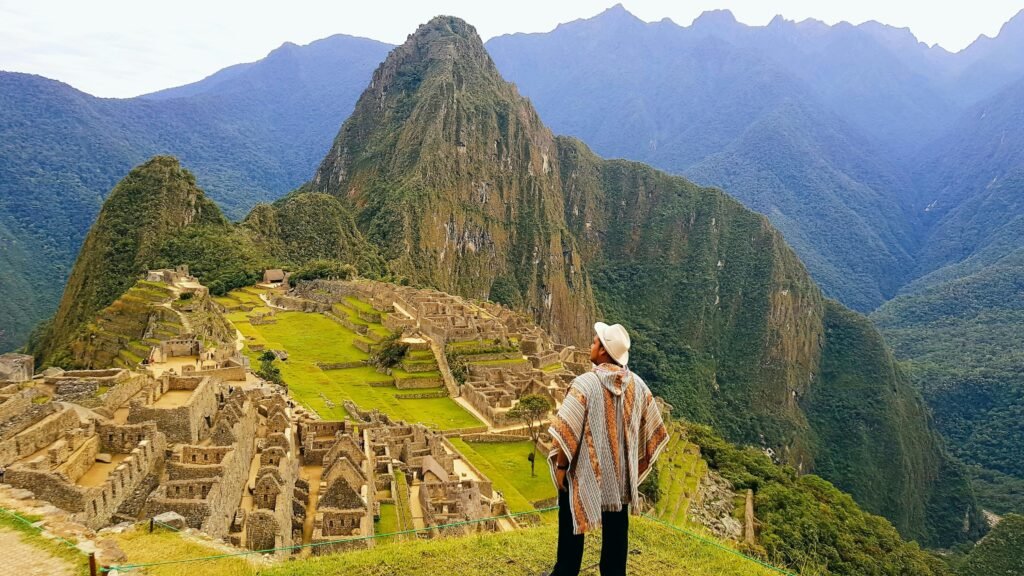
CULTURAL INSIGHTS: CONNECTING WITH THE LIVING HERITAGE
The Quechua Communities
The Inca Trail passes through regions where descendants of the Inca continue to preserve traditional ways of life. In villages near the trailhead and in the Sacred Valley, Quechua-speaking communities maintain ancient agricultural practices, textile traditions, and spiritual beliefs that provide context for the archaeological sites you’ll visit.
Many trekking companies employ porters and cooks from these communities, offering a meaningful opportunity for cultural exchange. Taking time to learn a few Quechua phrases, ask respectful questions about local customs, and understand the contemporary challenges these communities face adds immeasurable depth to your journey.
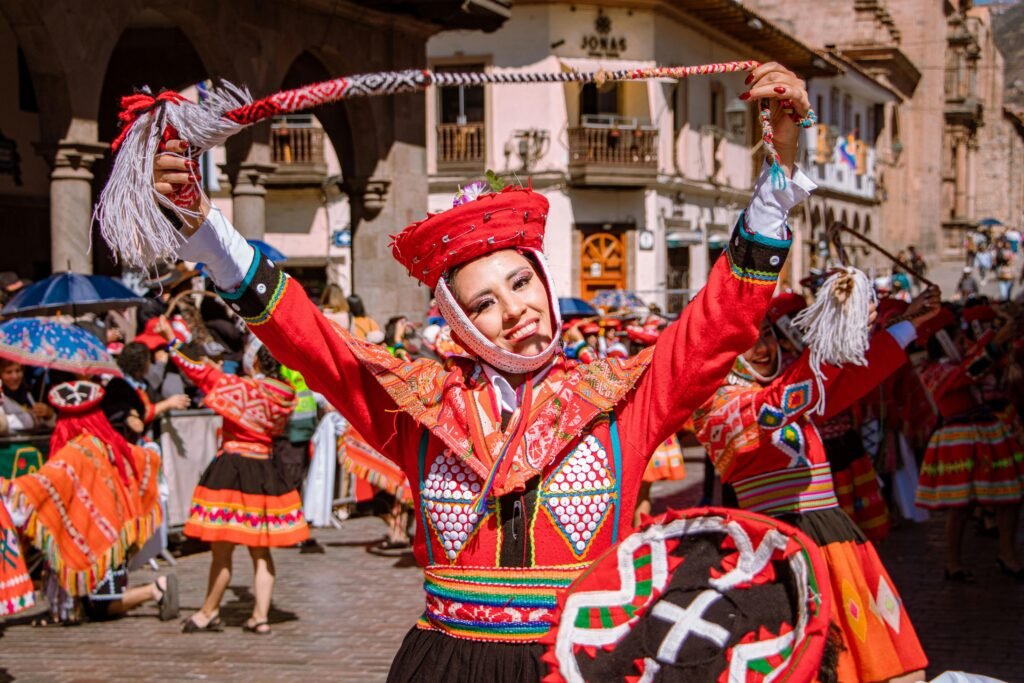
Understanding Sacred Geography
For the Inca and their descendants, the landscape itself is alive with spiritual significance. Mountains (apus) are revered as deities, and features like unusual rock formations, caves, and springs (huacas) serve as points of connection between the human and spirit worlds.
As you trek, you’ll notice small offerings of coca leaves at certain locations—a practice that continues from pre-Columbian times. Your guide can help identify these sacred places and explain the cosmological beliefs that informed the placement and design of sites along the trail.
Ceremonies and Rituals
Many tour operators begin the Inca Trail experience with a despacho ceremony—an offering to Pachamama (Mother Earth) and the mountain spirits requesting permission and protection for the journey. Participating in this ritual with an open mind provides insight into Andean spirituality and sets an intention of respect for the path ahead.
Throughout the trek, guides often share traditional stories, explaining how constellations, weather patterns, and plant life fitted into the Inca understanding of the universe. These perspectives invite you to experience the landscape not just as scenery but as a living text encoded with cultural meaning.
Responsible Cultural Engagement
Meaningful cultural exchange requires thoughtful participation:
- Ask permission before photographing local people
- Learn the context of crafts and textiles before purchasing
- Respect restricted areas at archaeological sites
- Consider fair compensation for knowledge and services
- Recognize that cultural practices are living traditions, not performances for tourists
ENVIRONMENTAL CONSIDERATIONS: PRESERVING THE PATH
Conservation Challenges
The Inca Trail’s popularity creates inevitable environmental pressure. Current challenges include:
- Erosion of historic stone pathways
- Waste management in remote locations
- Impact on sensitive alpine and cloud forest ecosystems
- Water source contamination
- Stress on local plant and animal populations
The permit system, while sometimes frustrating for travelers, represents a crucial management tool for preserving the trail. By limiting daily trekkers and enforcing regulations, authorities strive to balance access with conservation.
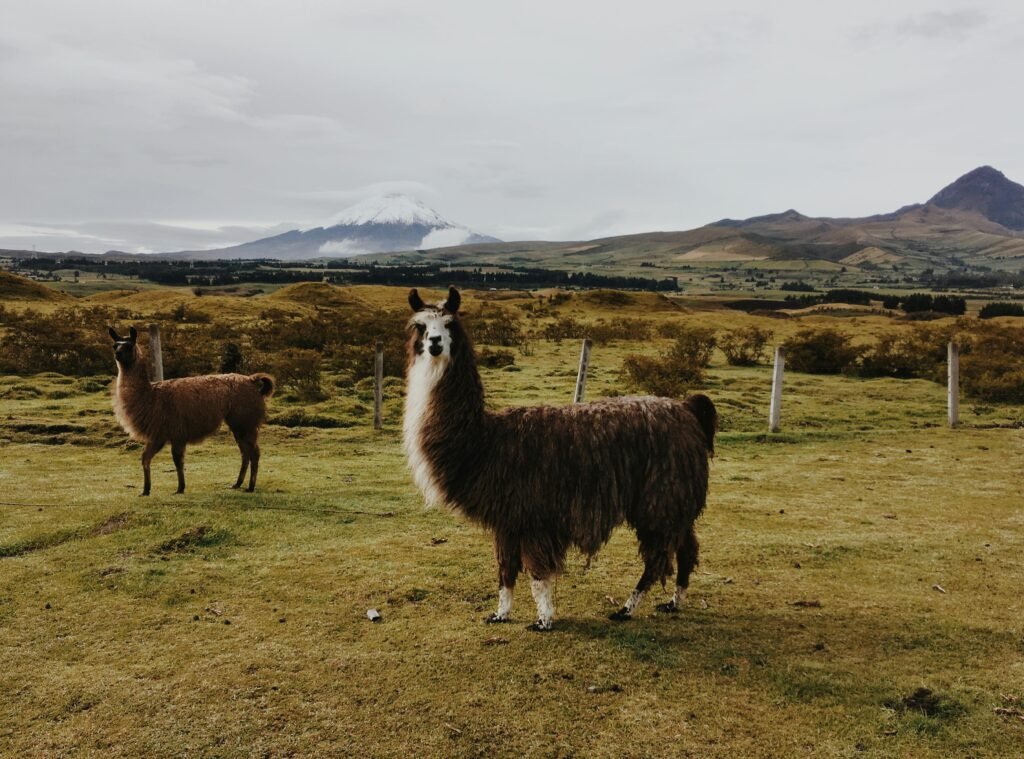
Minimizing Your Impact
Every trekker bears responsibility for preserving this irreplaceable heritage:
- Pack it in, pack it out: Carry all waste until proper disposal points
- Stay on designated trails: Cutting switchbacks causes erosion
- Respect wildlife: Observe animals from a distance and never feed them
- Minimize campsite impact: Use established areas only
- Water conservation: Use biodegradable soap and wash at least 100 feet from water sources
- Cultural sites: Never remove artifacts or add graffiti
- Energy use: Carry out used batteries and minimize unnecessary electronics
Choosing Responsible Operators
Not all trekking companies uphold the same environmental and ethical standards. Research potential operators with these questions:
- Do they provide proper equipment and training for porters?
- What are their waste management practices?
- Do they source food locally when possible?
- Do they educate clients about environmental and cultural sensitivity?
- Are they involved in conservation initiatives?
Companies that invest in sustainability, fair labor practices, and community development deserve your support, even if they charge slightly more than budget alternatives.
PHOTOGRAPHY AND VIDEOGRAPHY: CAPTURING THE MAGIC
Essential Equipment
While professional photographers might trek with extensive gear, most travelers need to balance quality with weight considerations:
- Camera: A weather-resistant camera with manual controls offers versatility
- Lenses: A wide-angle lens (16-35mm equivalent) for landscapes and a medium zoom (24-70mm equivalent) for versatility
- Filters: Polarizing filter to enhance skies and reduce glare
- Storage: Multiple memory cards (at least 64GB total)
- Power: Extra batteries and a portable charger
- Protection: Weather-sealed bag or cover
- Support: Lightweight travel tripod for low-light conditions
- For smartphones: External lens attachments, stabilizer, and waterproof case
The Inca Trail is a unique experience learn more hiking photography tips here
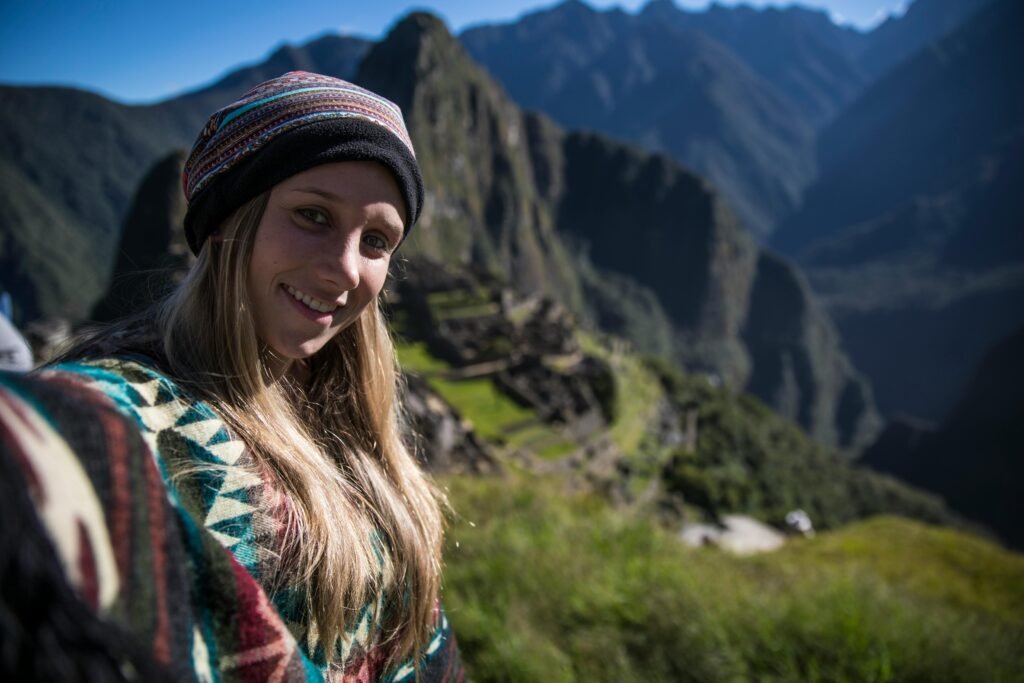
Capturing the Experience
Beyond technical considerations, thoughtful composition elevates your images:
- Golden hours: The hour after sunrise and before sunset offers magical lighting
- Scale: Include hikers or known objects to convey the immensity of the landscape
- Details: Document small elements like native flowers, textured stonework, and cloud formations
- Storytelling: Capture the journey’s progression, from preparation to celebration
- Human element: Respectfully photograph your fellow trekkers and local people (with permission)
- Weather drama: Mist, rain, and dramatic clouds often create more compelling images than clear skies
Practical Tips for Trail Photography
Photography on the Inca Trail presents unique challenges:
- Weight management: Prioritize versatility over specialized equipment
- Accessibility: Keep your camera in a hip belt case for quick access
- Battery conservation: Turn off unnecessary functions and keep batteries warm
- Protection: Guard against humidity with silica gel packets
- Respect: Never risk damaging archaeological sites for a photo, and follow site-specific rules
- Presence: Balance documentation with experience—don’t view the entire journey through a viewfinder
Sharing Respectfully
Social media sharing has transformed how we experience destinations. Consider these principles:
- Respect closed or sacred areas that prohibit photography
- Avoid geotagging precise locations of sensitive ecological or archaeological sites
- Share educational content that promotes conservation along with your images
- Consider how your portrayal of local communities might impact them
PRACTICAL INFORMATION: OPTIMIZING YOUR EXPERIENCE
Best Season to Trek
While the Inca Trail is technically open year-round (except February, when it closes for maintenance), seasonal considerations significantly impact your experience:
Dry Season (May to September):
- Advantages: Minimal rain, clearer skies, more reliable views of Machu Picchu
- Disadvantages: Larger crowds, higher prices, colder nights (especially June-July)
- Peak months: June, July, and August see the most visitors and earliest permit sellouts
Shoulder Seasons (April and October-November):
- Advantages: Fewer crowds, lusher landscapes, milder temperatures
- Disadvantages: Increased possibility of rain, especially afternoon showers
- Special features: April brings wildflowers; October offers greenery with clearing weather
Rainy Season (December to March):
- Advantages: Vibrant landscapes, fewer trekkers, easier permit availability
- Disadvantages: Persistent rain, foggy views, muddy trails, increased risk of landslides
- Note: The trail closes completely in February for maintenance

Altitude Sickness Prevention and Management
The Inca Trail’s high elevation poses a significant health consideration:
Prevention strategies:
- Minimum 2-3 days acclimatization in Cusco or the Sacred Valley before trekking
- Gradual ascent when possible
- Hydration (2-3 liters daily at minimum)
- Moderate physical exertion during acclimatization
- Light, carbohydrate-rich meals
- Avoidance of alcohol and tobacco
- Medication options (consult your doctor):
- Acetazolamide (Diamox) as a preventative measure
- Coca tea as a traditional remedy
Symptoms to monitor:
- Mild: Headache, nausea, fatigue, loss of appetite, dizziness
- Severe: Persistent intense headache, vomiting, shortness of breath, confusion
Response protocol:
- Mild symptoms: Rest, hydration, light food, acetaminophen for headache
- Worsening symptoms: Inform your guide immediately, consider descent
- Life-threatening symptoms: Immediate descent and medical attention
Food and Water on the Trail
Nutrition plays a crucial role in trekking success:
With guided tours:
- Expect surprisingly elaborate meals prepared by trail chefs
- Typical offerings include:
- Breakfast: Porridge, pancakes, eggs, fruit, hot drinks
- Lunch: Soup, sandwiches, cooked entrées, hot drinks
- Dinner: Multiple courses featuring Peruvian specialties, soups, and desserts
- Snacks: Popcorn, cookies, hot chocolate during afternoon tea
Water considerations:
- Guided tours typically provide boiled water for refilling bottles
- Independent trekkers should bring purification tablets, filters, or UV purifiers
- Minimum 2-3 liters carrying capacity recommended
- Electrolyte supplements help prevent dehydration
Dietary restrictions:
- Vegetarian, vegan, and gluten-free options available with advance notice
- Bring specialized energy bars or supplements for specific dietary needs
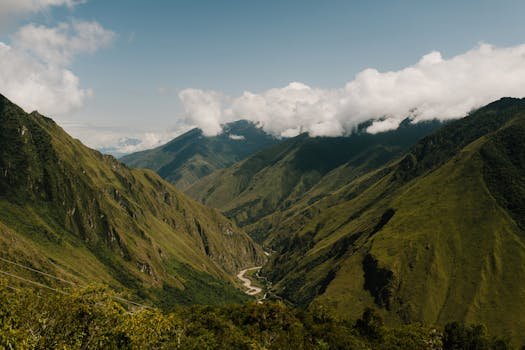
Toilet Facilities and Hygiene
Managing expectations regarding facilities enhances comfort:
Campsite facilities:
- Basic toilet blocks at major campsites
- Some sites have cold-water sinks for washing
- Toilet paper typically not provided
On-trail options:
- Limited designated toilet stops between campsites
- “Leave no trace” principles apply for emergency situations
Hygiene recommendations:
- Hand sanitizer (frequent use essential)
- Wet wipes for daily cleaning
- Quick-dry antimicrobial towel
- Biodegradable soap
- Women’s hygiene products (and disposal bags)
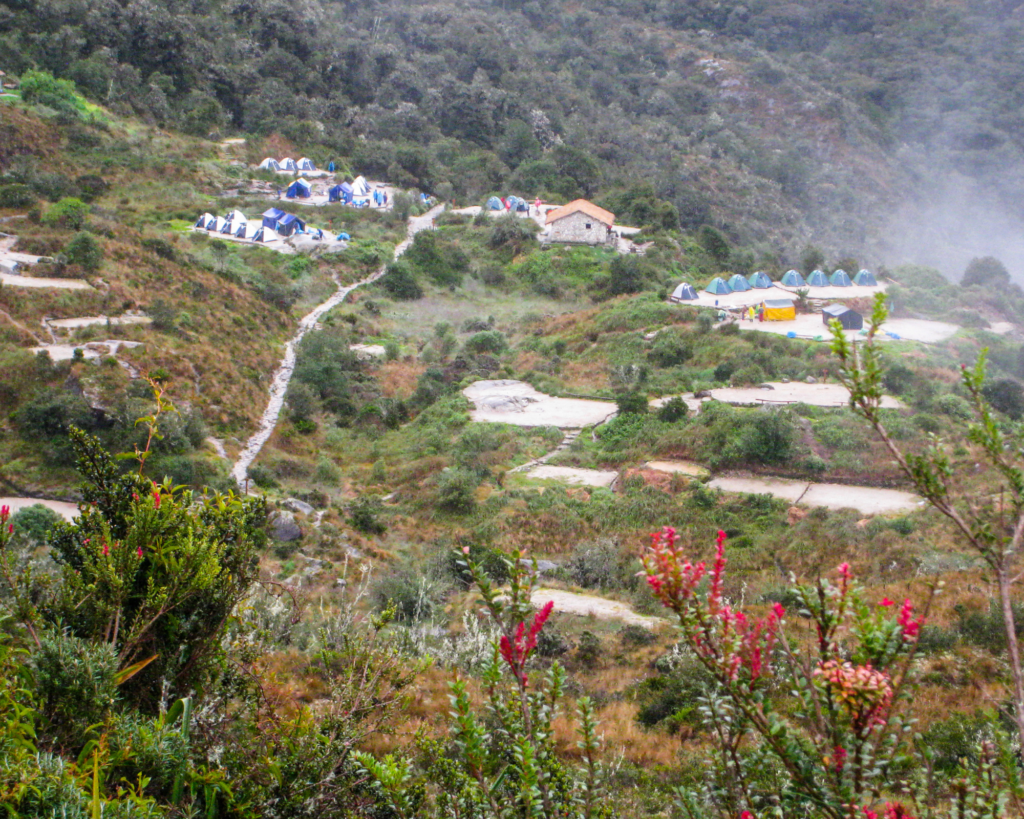
Money and Communications
Prepare for limited services while trekking:
Money:
- Carry small denominations (10-50 soles) for emergency purchases
- Tips for guides and porters (recommended: 60-100 soles for guides, 40-60 soles for porters)
- No ATMs available on the trail
Communications:
- Cell service extremely limited to nonexistent on most of the trail
- Guides carry emergency communication equipment
- Consider a local SIM card for use in Cusco and Aguas Calientes
- Inform family/friends of your limited connectivity in advance
Safety Considerations
While the Inca Trail is generally safe, preparedness prevents problems:
Medical preparation:
- Comprehensive travel insurance with emergency evacuation coverage
- Personal medical kit with prescribed medications
- Disclosure of pre-existing conditions to your guide
- Location of nearest medical facilities (provided by guides)
Security:
- The trail is patrolled and generally very safe
- Basic precautions with valuables in Cusco and Aguas Calientes
- Secure valuable documents in waterproof containers
Emergency protocols:
- Guides are trained in first aid and emergency response
- Evacuation procedures for serious situations
- Alternative routes and contingency plans for adverse weather
EMBRACING THE JOURNEY: BEYOND THE DESTINATION
The Inca Trail represents far more than a path to Machu Picchu—it’s a journey through ecological wonders, cultural heritage, and personal challenge that transforms many who walk it. While reaching the Sun Gate offers an incomparable sense of achievement, the most profound memories often come from unexpected moments along the way:
The camaraderie that develops with fellow trekkers as you share challenges and triumphs. The silence of the mountains in early morning mist. The ancient stairs that connect you physically to those who built them centuries ago. The moment when exhaustion transforms into exhilaration atop a high pass. The guide’s stories that bring stone ruins to life with human drama and spiritual significance.
As you prepare for your journey, remember that the Inca Trail rewards those who approach it with both thorough preparation and openness to serendipity. The trail’s magic lies not just in its spectacular terminus but in the transformative process of walking an ancient path with presence and reverence.
In the words of a traditional Quechua blessing often shared at the journey’s beginning: “May your feet walk lightly on Pachamama, your eyes see clearly her beauty, your heart open to her wisdom, and your spirit return home changed by the encounter.”
Allillanchu (Be well) on your journey.

ADDITIONAL RESOURCES
Recommended Reading
- “Turn Right at Machu Picchu” by Mark Adams
- “The Last Days of the Incas” by Kim MacQuarrie
- “The White Rock: An Exploration of the Inca Heartland” by Hugh Thomson
- “The Conquest of the Incas” by John Hemming
Useful Websites and Apps
- Peru’s Official Tourism Website: www.peru.travel
- Inca Trail Reservations: www.machupicchu.gob.pe
- Weather Forecasts: www.accuweather.com/en/pe/cusco
- Altitude Sickness Information: www.altitude.org
Responsible Travel Organizations
- Pack Light Peru (porter welfare): www.packlightperu.org
- Conservation International Peru: www.conservation.org/peru
- Mountain Institute: www.mountain.org/andes

